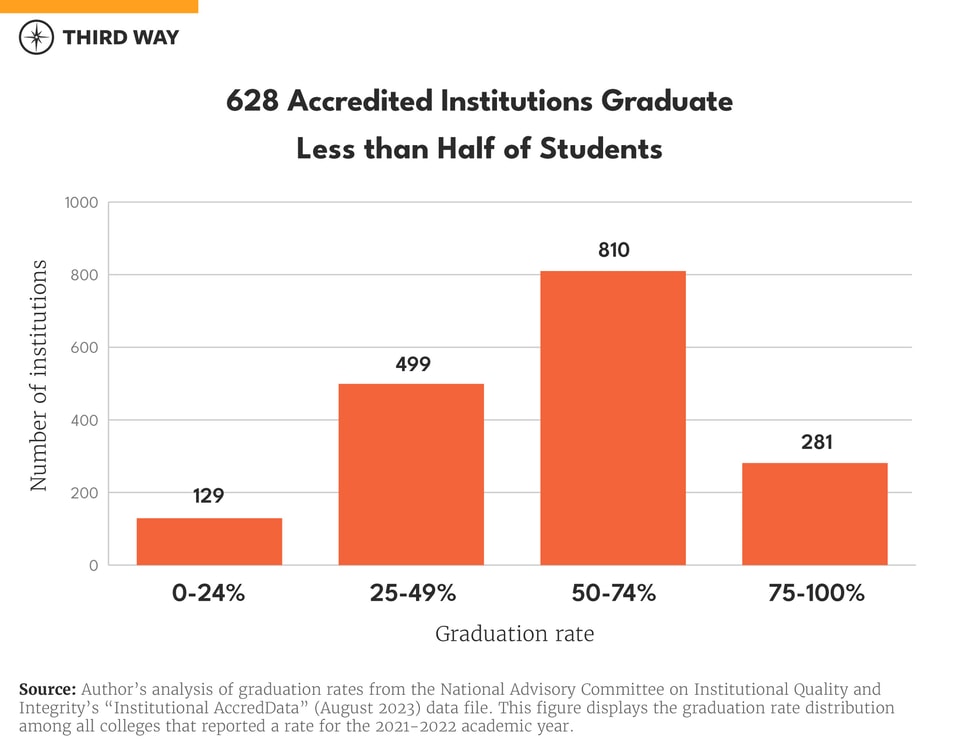Blog Published February 6, 2024 · 5 minute read
When Will the Watchdogs Bite?
Emily Rounds

South University received $196 million in taxpayer dollars last year, and you can almost count their graduation rate on one hand—6%.1 American Intercontinental University collected $236 million, and the University of Phoenix was allotted $764 million.2 The universities graduated 14% of their respective students.3 If you thought that colleges and universities need a track record of strong student outcomes to gain access to taxpayer dollars, think again. Billions of taxpayer dollars are distributed annually to institutions that graduate miniscule portions of students, if any at all. And higher education accreditors are letting it happen.
Accreditors are the watchdogs of the higher education industry, charged with ensuring that institutions provide a quality education and use taxpayer dollars responsibly. With an accreditor’s stamp of approval, colleges get access to a pot of more than $106 billion in annual federal Title IV funding—federal loans, grants, and campus-based aid.4 Clearly, accreditors are not delivering on their charge as they continue to approve institutions with abysmal outcomes where students and taxpayers will see little or no return on investment. It begs the question—when will the watchdogs bite?
37% of Accredited Institutions Graduate Less than Half of Students
In the 2021–2022 academic year, 37% of accredited, predominantly bachelor’s degree-granting institutions graduated less than half of their students.5 That same year, those schools received $20 billion in taxpayer-funded student aid dollars.6 Despite their dismal graduation outcomes, these institutions continued to receive billions in Title IV funding because they are accredited.

Unsurprisingly, post-enrollment earnings at schools that graduate less than half of their students are unimpressive at best. Ten years after enrolling, students at these 628 schools earn a median annual salary of $43,180, only $6,249 more than the median high school graduate (who earned an estimated $36,931 in 2022).7 On top of that, 136 of these institutions fail to equip most students to earn more than a typical high school graduate a full decade after enrolling.8
And these institutions continue to charge high tuition rates, even though they fail to equip students with strong earnings. The average annual price of a bachelor’s degree from a school that graduated less than half its students in 2021-2022 was $15,920.9 Taken over four years of the degree, it would cost, on average, $63,680—on the high end of the tuition spectrum (the average net price of a bachelor’s degree among all colleges that year was $78,092) given that some of these schools cannot even guarantee that most students will out-earn a high school graduate.10
Taxpayers Signed a Check for Nearly $4 Billion to 129 Schools that Graduate Less than a Quarter of Students
Failing to graduate at least half of students may be bad, but outcomes are even worse at other institutions. In 2021–2022, 129 accredited schools graduated less than 25% of their students while collectively taking in just shy of $4 billion in taxpayer dollars.11 And students attending these institutions earn a median salary of $37,589 10 years after enrollment—only $658 more than the typical high school graduate.12
Schools that graduate less than 25% of students also enroll an average of 51% Pell Grant recipients—meaning the majority of their students come from lower-income backgrounds and are eligible for federal need-based aid to help them afford college.13 Providing strong outcomes for Pell students should be a priority. Unfortunately, institutional outcomes do not always reflect that commitment. For example, 68% of Strayer University’s students are Pell recipients.14 The school boasts a 17% graduation rate and collected $446 million in federal dollars in 2021–2022.15 At Colorado Technical University, 67% of students are Pell recipients, and the university graduated 23% of students last year and received $364 million in federal dollars.16
Accreditors perpetuate a cycle that rewards institutions for poor student outcomes. The formula for predatory institutions is simple: recruit and enroll students, pocket their federal aid dollars, and cross their fingers and hope that they’ll graduate. As long as students are enrolled, the federal funding tap stays on and floods poor-performing institutions with little regard for student success and postgraduate outcomes. There is no incentive to graduate students and equip them with a return on tuition when institutions are practically guaranteed an accreditor’s stamp of approval and federal dollars. To repair this broken system, the Department of Education and Congress must act to require accreditors to set and uphold baseline standards of quality for student success and ensure that institutions and the accrediting agencies that prop them up are held accountable when they miss the mark.17
Conclusion
The watchdogs are sleeping on the job. Accreditors are charged with protecting students and taxpayers from bad actors, but when the bad actors are caught red-handed, the watchdogs refuse to bite. In case you lost track, we did the math for you: taxpayers signed a check for $20 billion dollars to schools that graduated less than half of their students.18 For accreditation to do its job, agencies must center student outcomes in institution reviews to ensure a quality education and responsible use of funds. The Department must also use its authority to require accreditors to set student achievement benchmarks for the institutions that they accredit.
